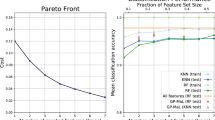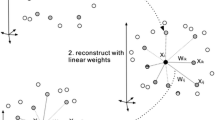Abstract
Manifold Learning has attracted much attention for this decade. One of the main features of Manifold Learning is that Manifold Learning tries to conserve local topologies in high-dimensional space. In this paper, we discuss the effect of the dimensionality reduction of input spaces of Evolutionary Learning. That is, we propose the use of Manifold Learning for Evolutionary Learning with redundant sensory inputs in order to avoid the difficulty of designing the allocation of sensors. The proposed method is composed of two stages: the first stage is to generate a mapping from higher dimensional sensory inputs to lower dimensional space, by using Manifold Learning. The second stage is using Evolutionary Learning to learn control scheme. The input data for Evolutionary Learning is generated by translating sensory inputs into lower dimensional data by using the mapping. We examine two Manifold Learning algorithms: Isomap and LLE. We adopt the Instance-Based Policy Optimization as an Evolutionary Learner. In addition, a metric of relative error of distances between original input space and reduced space is introduced. Experimental results of robot navigation problems show the effectiveness of the proposed method.


















Similar content being viewed by others
References
Andoni A, Indyk P (2008) Near-optimal hashing algorithms for approximate nearest neighbor in high dimensions. Comm ACM 51(1):117–122
Chen L, Buja A (2006) Local multidimensional scaling for nonlinear dimensionality reduction, graph layout, and proximity analysis. PhD thesis, University of Pennsylvania
Goldberg DE (1989) Genetic algorithms in search, optimization and machine learning, Addison-Wesley, Reading
Handa H, Ninomiya A, Horiuchi T, Konishi T, Baba M (2001) Adaptive state construction for reinforcement learning and its application to robot navigation problems. In: Proc 2001 IEEE Sys Man and Cybernetics Conf, pp 1436–1441
Handa H (2011) Dimensionality reduction of scene and enemy information in Mario. In: Proc. 2011 IEEE Inter Congress on Evol Comp CD-ROM
Hansen N, Ostermeier A (1996) Adapting arbitrary normal mutation distributions in evolution strategies: the covariance matrix adaptation. In: Proc 1996 IEEE Inter Conf on Evol Comp, pp 312–317
Hiroyasu T, Miki M, Sano M, Shimosaka H, Tsutsui S, Dongarra J (2003) Distributed probabilistic model-building genetic algorithm. In: Proc 2003 Genetic and Evol Comp Conf, pp 1015–1028
Hugues L, Bredeche N (2006) Simbad: an autonomous robot simulation package for education and research. In: Proc Sim Adaptive Behavior (SAB 2006), pp 831–842
Huo X, Ni XS, Smith AK (2007) A survey of manifold-based learning methods. In: Liao TW, Triantaphyllou E (eds) Recent advances in data mining of enterprise data. World Scientific, Singapore
Lee JA, Verleysen M (2008) Quality assessment of nonlinear dimensionality reduction based on K-ary neighborhoods. JMLR Workshop and Conf Proc (New challenges for feature selection in data mining and knowledge discovery) 4:21–35
Lee JA, Verleysen M (2008) Rank-based quality assessment of nonlinear dimensionality reduction. In: Proceedings of ESANN 2008, 16th European Symposium on artificial neural networks, pp 49–54
Miikkulainen R, Stanley K (2002) Evolving neural networks through augmenting topologies. Evol Comput 10(2):99–127
Mika S, Scholkopf B, Smola A, Muller K-R, Scholz M, Ratsch G (1999) Kernel PCA and de-noising in feature spaces. Adv Neural Info Proc Sys 11:536–542
Miyamae A, Sakuma J, Ono I, Kobayashi S (2009) Instance-based policy learning by real-coded genetic algorithms and its application to control of nonholonomic systems. Tran Jpn Soc Artif Intell 24(1):104–115
Najafi M, Beigy H (2009) Using PCA to improve evolutionary cellular automata algorithms. In: Proc. 2009 Genetic and Evol Comp Conf, pp 1129–1130
Nishizuka K, Yairi T, Machida K (2005) Simultaneous localization and mapping of mobile robot using nonlinear manifold learning. In: Proc 36th Inter Sympo on Robotics
Obayashi S, Sasaki D (2003) Visualization and data mining of Pareto solutions using self-organizing map. In: Proc 2nd Inter Conf on Evol Multi-Criterion Opt, pp 796–809
Roweis ST, Saul LK (2000) Nonlinear dimensionality reduction by locally linear embedding. Science 290(22):2323–2326
Tateyama T, Kawata S, Oguchi T (2006) A teaching method using a self-organizing map for reinforcement learning. Artif Life Robot 7(4):193–197
Tenenbaum JB, de Sliva V, Lagford JC (2000) A global geometric framework for nonlinear dimensionality reduction. Science 290(22):2319–2323
Acknowledgments
This work was partially supported by the Grant-in-Aid for Exploratory Research, the Grant-in-Aid for Scientific Research (B), and the Grant-in-Aid for Young Scientists (B) of MEXT, Japan (18656114, 21360191, 21700254, and 23700267).
Author information
Authors and Affiliations
Corresponding author
Rights and permissions
About this article
Cite this article
Handa, H. On the effect of dimensionality reduction by Manifold Learning for Evolutionary Learning. Evolving Systems 2, 235–247 (2011). https://doi.org/10.1007/s12530-011-9036-z
Received:
Accepted:
Published:
Issue Date:
DOI: https://doi.org/10.1007/s12530-011-9036-z




